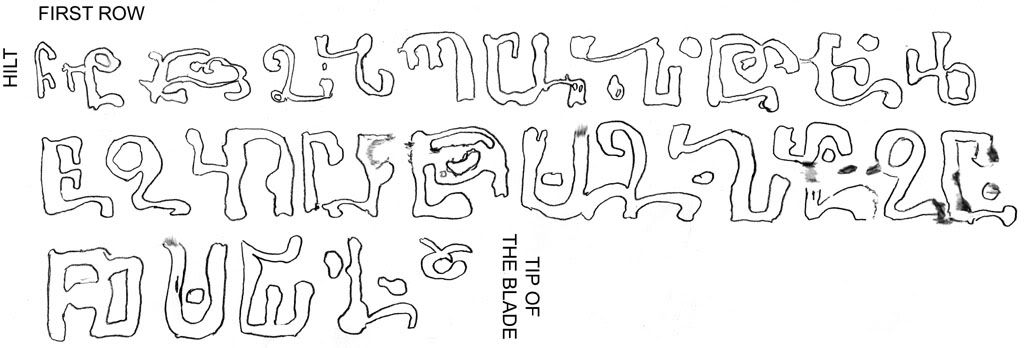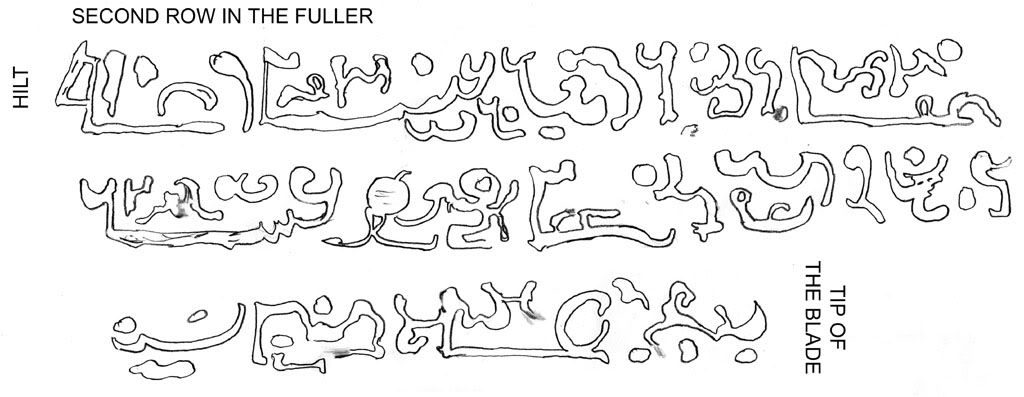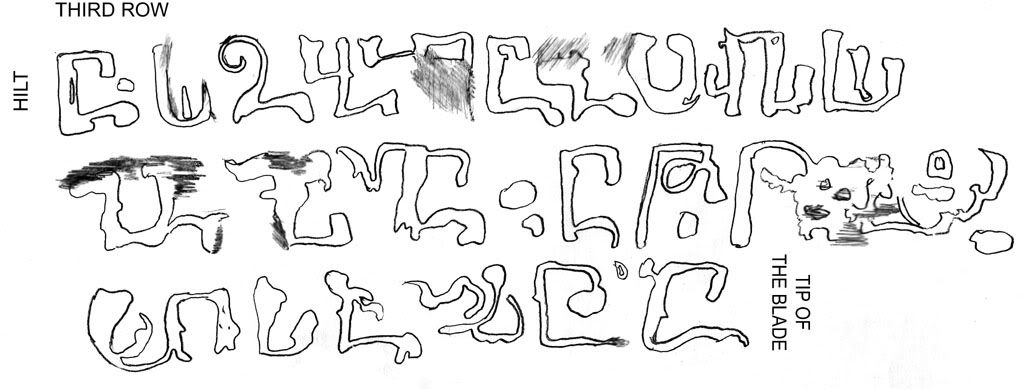
 |
|
|
#1 |
|
Member
Join Date: Dec 2004
Location: Poland, Krakow
Posts: 421
|
Hello all!
I have a question. On the pictures you can see a very huge sword - 110cm/43inch. long - it's bigger than sabre  The shape of the handle is like of Caucasian knives, the blade is quite solid, thick not cheap metal, but resilient, with fuller on both sides in the centre. On the blade are etched squiggles, and ornaments with letters or just pretending the letters (sorry no photo of this part). Main question is: do you think it's Caucasian or Persian - like some catalogues described it. I'm sure it's 19th century, maybe even 2nd half of the century. But what was the purpose of such huge weapon - only ceremonial? It is made very solidly, just like the weapon for use, but its size seems to be ridicoulus  . .I'm waiting for your opinions Thank you in advance and regards! |
|
|

|
|
|
#2 |
|
Member
Join Date: Dec 2004
Location: Ann Arbor, MI
Posts: 5,503
|
We usually attribute those to Persia and call them Qama, but I have never seen the "sword" -size one: at the most, they are large kindjals, up to 25inch total or thereabouts. This one is huge and obviously could not be used as a "kindjal", or secondary, sidearm. Should be looking elsewhere.
There is a semi-mythical Chechen sword, called Kaldan (with a crossguard, however) and there are swords with kindjal-type handles in Eastern Caucasian region (Daghestan, Chechnya). One is even illustrated in, I think, Askhabov' s book. I shall take pics. That is what I think it is. |
|
|

|
|
|
#3 |
|
Member
Join Date: Dec 2004
Posts: 655
|
Here is another monster that was sold by Artzi (43 inches). He identifies it as persian, and the engravings are quite typical persian work (I would guess ?).
I think it is somewhat similar to your sword. P.S. It would be really great to see the letters on your sword. |
|
|

|
|
|
#4 |
|
Member
Join Date: Dec 2004
Location: Poland, Krakow
Posts: 421
|
Thank you Ariel and Rivkin.
Indeed, the handle and the fuller of Artzi's piece are the same. I'll try to take a picture of these "letters" in a few days, but can't promise. It's good to hear you're tending to call it Persian. In one of the catalogues it was called "shamshir" - but I'm not convinced it's a proper name for such "monster"  Regards! |
|
|

|
|
|
#5 |
|
Member
Join Date: Jan 2005
Location: Haifa, Israel
Posts: 183
|
Hi all
An interesting sword indeed. In all our career we have examined three such swords, all of huge dimensions (we call it Qama to end all Qamas). 42-45 inches total length, 4-5 inches wide. One of these is posted above by Rivkin. The other one is shown below:  For more details on this sword see:Huge Qama Another similar sword is shown in Tirri’s book, page 206, Fig 143, shown next to a normal size kindjal and defined as Quadarra. In our opinion, these are Persian, Qajar period, second half of the 19C. In spite of the well forged steel, good sharp edges and good workmanship altogether these are ceremonial swords and not a fighting weapons. They are too big and cumbersome for battle use. We have heard several suggestions as execution swords, swords used in the Ashura celebrations of the Shiites etc. One more word on our sword posted by Rivkin: It was originally purchased in Jerusalem in 1918, wandered to the USA and returned to Israel. This gives a latest possible date for it. |
|
|

|
|
|
#6 |
|
Member
Join Date: Dec 2004
Location: Ann Arbor, MI
Posts: 5,503
|
Here it is, and it is, of course, from the Bible of Caucasian swords: Astvatsaturyan. It is a Khevsur Palasche. The handles on those were covered with brass, just like the regular Khevsur swords (on top). I guess, the swords under discussion in this thread are, indeed, Persian. The Khevsur ones were not ceremonial: these people were too poor to manufacture ceremonial weapons. The price of a sword labeled "David Ferrara " was 25 cows, the simple straight "pranguli" cost 10-12 cows and the simplest one, "rusuli", 2-3 cows. At prices like that nobody could afford a "toy" weapon.
|
|
|

|
|
|
#7 |
|
Member
Join Date: Dec 2004
Posts: 655
|
There is such thing as a georgian mega-kindjal, called satevari ("attack"). I have seen examples with total length of 27+ inches, and heard of XVIIIth century ones that were up to 35+ inches. I have never heard of anything larger than 40 inches.
At the same time these mega-kamas remind me of japanese "swords of gods", humongous, up to 10 feet long, but very high quality and quite functional swords, attributed to great heroes and gods of the past. Concerning the ritual connection to ashura: I have seen lots of spires, knives and whips being used, but I can not imagine anything repeatable about someone taking this 7 pounds monster and trying to inflict some pain with it. However, in my very humble opinion, Qajar period is known for not very functional but very symbolic and may be even slightly apprehensive for a muslim weapons - like Gorz-mace. While the shia sect is a complete darkness to me, it is Shahnameh, not Quran, Hadith or anything of a traditional islam that fueled these "revival" forms. |
|
|

|
|
|
#8 |
|
Member
Join Date: Dec 2004
Location: Ann Arbor, MI
Posts: 5,503
|
I agree with Rivkin.
There may be some psychological undertone: Persians were losing one war after another and were much better swordmakers than swordwielders. Perhaps, as a compensation, they tended to exaggerate their past military glories, exploits of their national heroes and the grandiosity of their weapons. I have a strong suspicion that these giant Qamas were just an equivalent of "mine is bigger than yours". I also do not think these things were used for self-mutilation at Ashura festivals. The scalp wounds were in a large measure for show: bleed a lot but heal fast. With the giant Qama one could inadverently inflict some real damage..... |
|
|

|
|
|
#9 |
|
Member
Join Date: Dec 2004
Posts: 655
|
and I concur with Ariel
 . .The problem I always had with understanding Qajars is that on one side Qajars are from Azerbajan and they are turkoman. After 1820 they started to follow extremely pro-modern and somewhat anti-religious route, which included modernization of the army and later, imitation of russian military (which ended up with iranian "cossack" regiments). Azerbajan historical museum has an impressive collection of locally made gorz-maces, "revival" helmets and shields. The problem with me (and it's probably that I don't know iranian history that well) that pre-islamic pan-persian nationalism a-la Pahlavi have always been anti-azeri in nature (they were declared to be turkish-speaking northern persians), at the same time there is nothing panturanistic or even turkophilic about Qajar period weapons (even those made in Azerbajan). Was turkish nationalism so dead there that people considered persian culture their only choise for nationalistic expression ? Or was it symbol of a reunited countries, after almost a century of internal strife ? |
|
|

|
|
|
#10 |
|
Member
Join Date: Dec 2004
Location: Poland, Krakow
Posts: 421
|
Thank you for discussion Gentlemen. For answers on your questions you'll have to wait for someone else Rivkin, becasue in Persian history I'm definitely less educated than anyone of you.
Stupid but obvious question passed through my head yesterday. We're agree all this is Persian, and if it's Persian than it can be only 19th century. But this weapon, it's shape, sheath are characteristic for another country (or maybe only I think they are) - so do we have any historical resources this is Persian not, i.e. Caucasian - literature, drawings, etc.? Or maybe the size of this thing per se means Persian. On my piece there are symbols on the blade - ok, we can probably say they're Persian for sure, but what about other pieces, and conviction about their origin? 
|
|
|

|
|
|
#11 |
|
Member
Join Date: Dec 2004
Location: Poland, Krakow
Posts: 421
|
Well, it was real pain to take this pitures, so quality isn't the best. Here you can see etched blade. On one side something what could be letters, but it's hard to see on this pics, on the second side, just etched curled lines. On both side there is picture of "humanoid".
Regards! |
|
|

|
|
|
#12 |
|
Member
Join Date: Dec 2004
Posts: 655
|
Do you have a bigger resolution of the first picture ? The letters of two sides of a fuller are slightly reminding me of some caucasian alphabets (old georgian or even armenian).
|
|
|

|
|
|
#13 |
|
Member
Join Date: Dec 2004
Location: Poland, Krakow
Posts: 421
|
I'll try to take better picture tomorrow.
|
|
|

|
|
|
#14 |
|
Member
Join Date: Dec 2004
Location: Poland, Krakow
Posts: 421
|
I don't know if these picture will do, but let's make a try.I can upload bigger pics on photobucket if those posted below won't be enough.
One thing seems to be sure: these aren't Persian letters.  Thanks! |
|
|

|
|
|
#15 |
|
Member
Join Date: Dec 2004
Posts: 655
|
looks like very strange version of armenian to me. I will try to find out more.
|
|
|

|
|
|
#16 |
|
Member
Join Date: Dec 2004
Location: Ann Arbor, MI
Posts: 5,503
|
Armenian Kindjals were supposed to be big. Perhaps, that is what you have. This would be a very rare find!!!
|
|
|

|
|
|
#17 |
|
Member
Join Date: Dec 2004
Posts: 655
|
Have shown the writing to some armenians, they confirmed that the characters, with an exception of 2 are armenian (I guess it is probably some old dialect writing, so some characters can be different). Bigger resolution pictures would be appreciated, thanx in advance. I will try to see if someone can translate it.
|
|
|

|
|
|
#18 |
|
Member
Join Date: Dec 2004
Location: Poland, Krakow
Posts: 421
|
Rivkin - thank you very much for your efforts, I really appreciate it!
Does Armenian letters excludes Persia as a place of workmanship? I don't know if these (a little bigger) picture will help: pic1 pic2 pic3 pic4 pic5 pic6 The problem is, this is only a part of the blade. The letters are barely visible and it's a real pain taking them with camera. Thanks! |
|
|

|
|
|
#19 | |
|
Member
Join Date: Dec 2004
Posts: 655
|
Quote:
Now, when talking about Qajars - the early years of Qajars were marked by qajar army establishing control over entire azerbajan and eastern armenia, wrestling large armenian centers under their control. This ended with iranian defeat in ruso-iranian wars, with the borders being finalized in 1828, leaving iran with much smaller armenian diaspora. It well may be that the sword is early qajar and was made by an iranian sympatizer, even through early Qajars were far less popular among armenians due to their turkoman origins and their support of northern iranian turks (azeris etc.). It is also possible that the sword is of later period (if its indeed an armenian mega-kama), and in this case was most likely made in one of the armenian diaspora centers in Fars. |
|
|
|

|
|
|
#20 |
|
Member
Join Date: Dec 2005
Posts: 164
|
I am still trying to figure this one out
  It measures 21 and a half inches total blade 18 inches Just thought I would post it here too I am trying to translate the script  and the enhanced version 
|
|
|

|
|
|
#21 | |
|
Member
Join Date: Jan 2005
Location: Singapore
Posts: 1,248
|
Quote:
|
|
|
|

|
|
|
#22 |
|
Member
Join Date: Dec 2004
Posts: 655
|
I have shown it to many armenians, and they all basically confirm my opinion - 80% of letters are armenian, but the other 20% are not (at least they are not modern armenian). I will try to email some armenian studies professors around here.
|
|
|

|
|
|
#23 |
|
Member
Join Date: Dec 2004
Posts: 655
|
I have received a few replies. They all agree the language on the sides is armenian. The language in the fuller is not, probably persian (??).
The problem is that it is some obscure version of armenian, a few characters are not typical for armenian writing. They are puzzled on where it was made - they basically cited the same information on persian-armenian relationships I posted above, does not make our job any easier. They gave me a few adresses of armenians who might be capable to work with the signature, but the closest one to you is in Venice... They are asking is it is known how the kindjal ended up in Poland ? |
|
|

|
|
|
#24 |
|
Member
Join Date: Dec 2004
Location: Poland, Krakow
Posts: 421
|
Great work and thank you very much Rivkin.
No, we don't know how it finds itself in Poland, it was purchased in 1962 without any knowledge about it. Second time, so all in all in two Polish catalogues of arms and armour, I found this sword is called SHAMSHIR  . Is this some misunderstanding or something, or do we really can call this huge, big and clumsy sword with the name od light, slick sabre? . Is this some misunderstanding or something, or do we really can call this huge, big and clumsy sword with the name od light, slick sabre?
|
|
|

|
|
|
#25 |
|
Member
Join Date: Dec 2004
Location: Poland, Krakow
Posts: 421
|
Hello!
I draw the letters from the blade. My skills aren't fabulous  but I hope it will do. Anyway now everything is readable (I hope). Some of the letters are damaged because of abrasion or acid. but I hope it will do. Anyway now everything is readable (I hope). Some of the letters are damaged because of abrasion or acid.    Regards! |
|
|

|
|
|
#26 |
|
Member
Join Date: Oct 2005
Posts: 68
|
I have a similar piece 34 inches---is the inlay possibley Armenian too?
|
|
|

|
|
|
#27 |
|
Member
Join Date: Jan 2006
Posts: 1
|
both swords are persian. the larger one is a persian heavy blade which dates back before shamshir became popular. persian swords were double edge heavy blades just like that one the only problem was that it was too difficult for persian immortals to weild them thats why shamshir took over. designed in the town of shamshir in current kermanshah of iran refering to lion's tale. the curve made it much stronger and easier on impact at the same time smaller and lighter. head on collision with a heavy blade became possible with introcution of shamshir so those blades became obselete. the carvings on the sword definitely are persian carving though they are armenian and seems like it has mix of kofi but i can't make any thing out of it. kofi is hard to read in perfect writing let alone in that condition. it seems as if someone built the sword in memory of something if it is truley a 19th century. as for the second sword is persion and the writings are more modern kofi its still missing dots so its not current arabic and its not as bad as the old kofi. there are different types of swords being built even today. shamshir isn't poplur in some regions, they still like to build the heavy double edged ones but none of them are practical. i have only seen a few double edge swords that were practical but definitely not as good as shamshir.
|
|
|

|
|
|
#28 |
|
Member
Join Date: Dec 2004
Posts: 655
|
Sorry wovliex - I have shown the writing to many armenians. They can read the letters (with an exception that the ones in the middle are most likely persian), but it has no apparent meaning. Astvatsaturjan wrote about unintelligeble armenian writings, and that seems to be one of them.
Any way, very rare thing - Qajar Kama with armenian signature, congratulations. |
|
|

|
|
|
#29 |
|
Member
Join Date: Dec 2004
Location: Poland, Krakow
Posts: 421
|
Thank you for your efforts. I almost forgot about that thread
 This sword will be presented soon on big exhibition in Gdansk/Danzig, Poland, called "Wonders of Orient". There should be quite nice arms and armor group, while one of the authors of this exhibition is tireless prof. Zygulski. All the best Michal |
|
|

|
 |
|
|